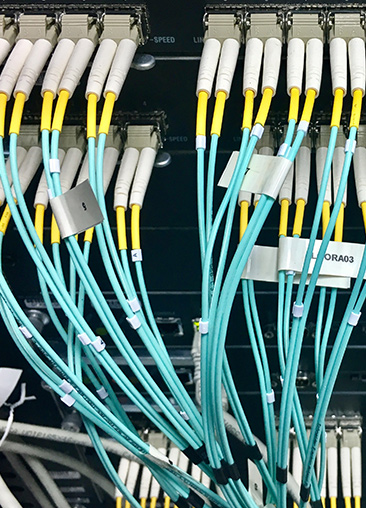5 Things To Consider When Choosing Cable for Automation Applications
Post By: Luke West On: 09-09-2021 Read Time: 4 minutes - Guides
Post By: Luke West On: 09-09-2021 Read Time: 4 minutes - Guides
Cables are used for all sorts of industrial automation applications, including data communications, automated machinery, power distribution and safety systems. If you're planning to overhaul your production line or install new equipment to replace old legacy systems, you'll need to draw up a detailed plan of the required cabling. When choosing cable for automation applications, you'll need to have a clear idea of the structure of your premises. This includes its interior and exterior locations, what kind of wiring network is currently in place, and how much of it will need to be replaced.

Industry 4.0 brings with it much more complex systems in the factory environment, providing more effective and consistent production as well as integrated business management. This expansion in the capabilities and scope of industrial automation incorporates an increase in IIoT (Industrial Internet of Things) networks, use of AI, and a greater reliance on robotics. All this means that you may be looking at much more advanced cabling solutions to achieve full connectivity and efficient data transmission. You may also need to understand the precise application of various types of cable, and how to maintain them to ensure that they continue to function optimally.
Most importantly, you need to select the appropriate cabling for your industrial environment, taking into account all its operating conditions. The following five factors should be considered when choosing cable for automation applications.
There are three types of cable commonly used in industrial automation, depending on the amount of movement required for your application:
Static cables can easily strain and break if forced into continuous movement. Flexible cables allow a certain degree of movement, but aren't designed for constant repetitive flexing. Continuous flex cables are intended for a flexible life cycle, and to work inside cable carriers for automated and moving machinery.
Choosing cable for automation applications depends primarily on what its function is, and what kind of environmental conditions it'll need to withstand. These might include challenging environments such as extremes of temperature or vibration, exposure to chemicals or other corrosive elements. It also depends on what kind of load the cable will be expected to carry. Many experts recommend choosing cables based on phase-to-phase voltage, so that they can be adjusted for the entry ports and cable jackets in your network. For complex logic devices and networked systems, you'll probably want to call in cable installation experts.
The size and type of cable you need for your specific setup must take into account its short-circuit rating, voltage regulation and current-carrying capacity. The cable's current carrying capacity is defined by how much current it can carry continuously without overheating. This depends on how the heat generated by the electrical activity is dissipated into the surrounding areas through the surface of the cable, which is largely determined by the type of insulation material it uses.
Cable conductors and insulation ratings must meet the demands of the application. Conductor materials like aluminium or copper, as well as thermal resistivity, play an important role in the system's safety. The finish and covering of the cable should also be selected according to the application environment.
When choosing cable for automation applications, you need to make sure that the cables are the right size to fit the layout of your unit and the dimensions of its individual devices. Cables can be selected for both indoor and outdoor installations in an industrial set-up, depending on what machines are being used and where they're placed. Local climatic conditions must be taken into account, as well as the layout of your premises and outdoor spaces. Those who carry out the installation should ensure that the fewest number of conduit bends are incorporated into the layout, pulling tensions are specified, and distances between manholes minimised.
Your cables must be shielded if your equipment is subject to an intense electric field, or there is significant fluctuation in power generation and distribution. In high and medium voltage applications, such conditions can cause air particles to ionise. This in turn will damage the cable's insulating cover and lead to the generation of ozone.
Any non-metallic cables should be shielded or provided with a metallic covering when operating in the following conditions:
Cable failure is not uncommon, and can be due to jacket abrasion or degradation, shield degradation, loss of continuity and corkscrewing. This happens when the shape of the cable is distorted into a corkscrew shape due to repetitive motion, and indicates that the conductors have shifted or migrated from their original positions. This in turn displaces other elements inside the cable and results in its undulating appearance. Continuous motion can also cause industrial cables to crack, particularly when they're exposed to extremes of temperature, hazardous oils or chemicals.
Cables lose continuity when an incorrect pitch direction or length causes the insulated conductor inside to become twisted. The cable is then unable to bear a mechanical load, and the tensile demand causes it to break. This can also happen if the cable selected for the flexing application uses insufficiently fine stranded conductors. Signals are also disrupted by abrading or degradation of the shielding or cable jacket, or constant bending that causes them to break.
Choosing the right cable for your automation applications will improve the efficiency and safety of your systems and benefit your productivity. Proper planning and expert advice are essential before you proceed to installation, to ensure you select the best and longest-lasting solution. If you choose the wrong types of cable for your automated industrial processes, cable failure could result, causing you disruption in productivity and costly downtime.